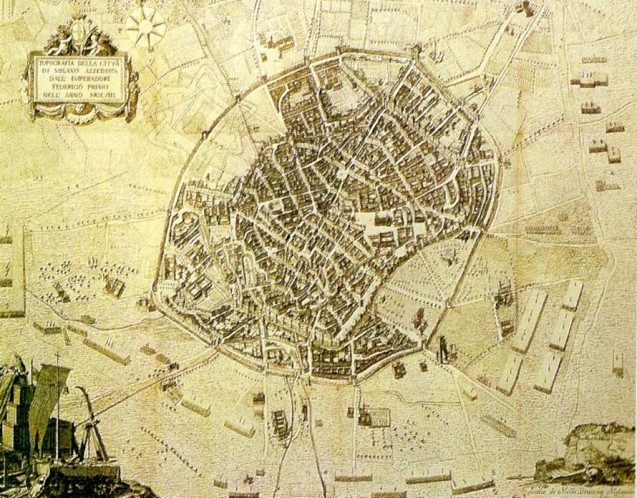Another note on Milan, the beautiful city that is the setting of our recently published gastronomic murder mystery, The Revenge of the Milanese Butcher! (Take a look, and if you’ve already bought a copy, please be sure to leave a review, thanks!) These notes are all related to the book in one way or another. We hope you enjoy them!
Milan’s medieval circular ring wall is now referred to as the Cerchia dei Navigli (the Navigli Ring, meaning Canal Ring). It was originally built as defense against Frederick Barbarossa. Didn’t work too well as he overran them easily and razed the city to the ground. Figuring they should try something new, a moat was also added around the walls. Not much luck this time either, again Federico took the city. That said, while they didn’t help much as defense works, this waterworks later formed the nucleus of Milan’s system of canals which brought it great wealth from trade…
(This is a map of Milan with its shiny new yet ineffectual medieval walls and moat… notice Barbarossa’s camps surrounding the city laying siege to it. Notice too the original Roman inner ring of walls, which the city had outgrown by the Middle Ages.)

The medieval walls had 6 main gates of which l’Antica Porta Ticinese and the Porta Nuova are the only two still standing. There were also 10 pusterle (posterns, or secondary gates); only the Pusterla di Sant’Ambrogio has survived.
While porte were bigger and posterns were smaller entrances into the city, the other difference was that the main gates lead to important cities whereas the pusterle primarily dealt with local traffic.
The medieval Porta Ticinese is also referred to in Milan as l’antica Porta Ticinese, not to be mistaken for the more “modern” 19th century gate further out on Corso di Porta Ticinese, where the 16th century “Spanish Walls” and gate once stood. It contains the marble relief “Madonna and Child with St. Ambrose Proffering the Model of the City”. This is the porta that leads towards Pavia.
The “inside the walls” view of the antica Porta Ticinese…
The other surviving gate is the Porta Nuova medievale which also has a marble relief, “Madonna and Child and Saints,” added to the gate between 1330-1339. This road that begins at this porta leads toward Monza.
The Pusterla di Sant’Ambrogio was constructed in 12th century and then greatly restored in 1939. This was one of the more grandiose posterns, a fortress in its own right, probably due to its strategic vicinity to the important Basilica of San’Ambrogio. The statues of the Saints in relief on the gate are of Saint Ambrogio, Gervasio and Protasio, added in the 14th century.
This final image is of Milan in the 16th century. The Spanish walls mentioned earlier are the newer, outermost, very fortified bastions with moat that surrounds the city, visible on the map. If you click on the image on the website however, the inner medieval gates and the narrower, inner moat that became the canals of the Cerchia dei Navigli (the topic of this note) are also noticeable.
Remember… the Cerchia dei Navigli and other unique places, history and secrets about Milan in our gastronomic murder mystery The Revenge of the Milanese Butcher, ItalianNotebook Press, available on Amazon.